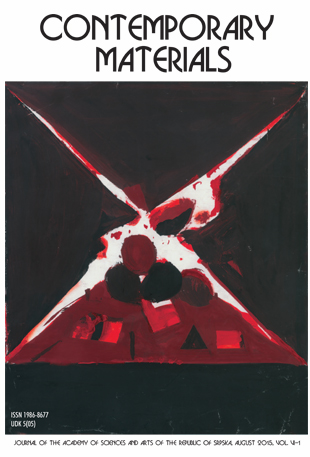INFLUENCE OF ANISOTROPY AND MAGNETIC FIELD ON THERMAL ENTANGLEMENT IN HEISENBERG MODEL AND THERMODYNAMIC ANALYSIS OF MODEL
DOI:
https://doi.org/10.7251/COMEN1702137PAbstract
The thermal entanglement in a two-qubit anisotropic Heisenberg XXZ system, also XYZ system, with Dzyaloshinskii-Moriya (DM) couplings in an inhomogenous magnetic field, was studied. The effects of these two kinds of anisotropies on the thermal entanglement have been studied in detail in the concept for concurrence, the measure of entanglement. The analytical expressions of concurrence are obtained for this model. It is found that the DM interaction can enhance thermal entanglement and can be efficiently controlled by the DM interaction parameter and ehchange interaction Jx, Jy and Jz. When D is large enough, the entanglement can exist for larger temperatures and strong magnetic field. We also analysed thermodynamic properties of Heisenberg model and the most important results were shown in the paper.References
E . Schrödinger, Naturwissenschaften 23, 807, 823, 844 (1935); (Schrödinger E, Proc. Am. Phil. Soc. 124, 323 (1980) Translated into English).
A. Einstein, B. Podolsky, N. Rosen, Can Quantum-Mechanical Description of Physical Reality Be Considered Complete?, Phys. Rev., Vol. 47 (1935) 777.
J. S. Bell, Оn the Einstein Podolsky Rosen paradox, Physics, Vol. 1 (1964) 195.
A. Aspect, P. Grangier, G. Roger, Experimental Tests of Realistic Local Theories via Bell's Theorem, Phys. Rev. Lett., Vol. 47, (1981) 460.
A. Aspect, P. Grangier, G. Roger, Experimental Test of Bell's Inequalities Using Time—Varying Analyzers, Phys. Rev. Lett., Vol. 49, (1982) 1804.
P. Kwiat, K. Mattle, H. Weinfurter et. al., New High-Intensity Source of Polarization-Entangled Photon Pairs, Phys. Rev. Lett., Vol. 75, (1995) 4337.
C. H. Bennett, G. Brassard, C. Crepeau et. al., Teleporting an unknown quantum state via dual classical and Einstein-Podolsky-Rosen channels, Phys. Rev. Lett., Vol. 70, (1993) 1895.
C. Macchiavello, G. M. Palma, Anton Zeilinger, Quantum Computation and Quantum Information Theory, World Scientific 2001.
L. Amico, R. Fazio, A. Osterloh et.al., Entanglement in many-body systems, Rev. Mod. Phys., Vol. 80 (2008) 517−576.
D. C. Li, X. P. Wang, Z. L. Cao, Thermal entanglement in the anisotropic Heisenberg XXZ model with the Dzyaloshinskii – Moriya interaction, J. Phys.: Condens. Matter, Vol. 20 (2008) 1−5.
F. Kheirandish, S. J. Akhtarshenas, H. Mohammadi, Effect of spin - orbit interaction on entanglement of two - qubit Heisenberg XYZ systems in an inhomogeneous magnetic field, Physical Review A, Vol. 77 (2008) 042309-1 - 042309-9.
V. Vedral, Introduction to Quantum Information Science, Oxford University Press, (2006).
L. Da-Chuang, C. Zhuo-Liang, Thermal Entanglement in the Anisotropic Heisenberg XYZ Model with Different Dzyaloshinskii – Moriya Couplings, CHIN. PHYS. LETT. Vol. 26 (2009) 020309-1.
K. Berrada, A. Chafik, H. Eleuch, Y. Hassouni, Concurrence in the framework of coherent states, Quantum Information Processing 2010 Vol. 9 (2009) 14-24.
G. H. Yang, W. B. Gao, L. Zhou, H. S. Song, The Entanglement in Anisotropic Heisenberg XYZ Chain with inhomogeneous magnetic field, arXiv:quant-ph/0602051
D. Lossa, D. P. DiVincenzo, Quantum Computation with Quantum Dots, arXiv:cond-mat/9701055
R. C. Ashoori, Electrons in artificial atoms, Nature, Vol. 379−6564 (1996) 413−419.
M. A. Kastner, Artificial Atoms, Physics Today 46−1 (1993) 24–31.
A. V. Syromyatnikov, S. V. Maleyev, Double peak specific heat feature in frustrated antiferromagnetic clusters, arXiv:cond-mat/0304572
Nanosys Quantum Dot Pioneers, Quantum Dots, http://www.nanosysinc.com/what-we-do/quantum-dots, (2015).
https://en.wikipedia.org/wiki/Quantum_dot
A. Predojević, Photon generation efficiency and entanglement in quantum dot systems, Contemporary materials, Vol. VII−2 (2016) 162−165.
M. Pantić, M. Rutonjski, P. Mali, M. P. Hrvojević, S. Radošević, Anisotropy influence on the striped antiferromagnetism, Contemporary materials, Vol. VII−2 (2016) 121−126.
A. Einstein, B. Podolsky, N. Rosen, Can Quantum-Mechanical Description of Physical Reality Be Considered Complete?, Phys. Rev., Vol. 47 (1935) 777.
J. S. Bell, Оn the Einstein Podolsky Rosen paradox, Physics, Vol. 1 (1964) 195.
A. Aspect, P. Grangier, G. Roger, Experimental Tests of Realistic Local Theories via Bell's Theorem, Phys. Rev. Lett., Vol. 47, (1981) 460.
A. Aspect, P. Grangier, G. Roger, Experimental Test of Bell's Inequalities Using Time—Varying Analyzers, Phys. Rev. Lett., Vol. 49, (1982) 1804.
P. Kwiat, K. Mattle, H. Weinfurter et. al., New High-Intensity Source of Polarization-Entangled Photon Pairs, Phys. Rev. Lett., Vol. 75, (1995) 4337.
C. H. Bennett, G. Brassard, C. Crepeau et. al., Teleporting an unknown quantum state via dual classical and Einstein-Podolsky-Rosen channels, Phys. Rev. Lett., Vol. 70, (1993) 1895.
C. Macchiavello, G. M. Palma, Anton Zeilinger, Quantum Computation and Quantum Information Theory, World Scientific 2001.
L. Amico, R. Fazio, A. Osterloh et.al., Entanglement in many-body systems, Rev. Mod. Phys., Vol. 80 (2008) 517−576.
D. C. Li, X. P. Wang, Z. L. Cao, Thermal entanglement in the anisotropic Heisenberg XXZ model with the Dzyaloshinskii – Moriya interaction, J. Phys.: Condens. Matter, Vol. 20 (2008) 1−5.
F. Kheirandish, S. J. Akhtarshenas, H. Mohammadi, Effect of spin - orbit interaction on entanglement of two - qubit Heisenberg XYZ systems in an inhomogeneous magnetic field, Physical Review A, Vol. 77 (2008) 042309-1 - 042309-9.
V. Vedral, Introduction to Quantum Information Science, Oxford University Press, (2006).
L. Da-Chuang, C. Zhuo-Liang, Thermal Entanglement in the Anisotropic Heisenberg XYZ Model with Different Dzyaloshinskii – Moriya Couplings, CHIN. PHYS. LETT. Vol. 26 (2009) 020309-1.
K. Berrada, A. Chafik, H. Eleuch, Y. Hassouni, Concurrence in the framework of coherent states, Quantum Information Processing 2010 Vol. 9 (2009) 14-24.
G. H. Yang, W. B. Gao, L. Zhou, H. S. Song, The Entanglement in Anisotropic Heisenberg XYZ Chain with inhomogeneous magnetic field, arXiv:quant-ph/0602051
D. Lossa, D. P. DiVincenzo, Quantum Computation with Quantum Dots, arXiv:cond-mat/9701055
R. C. Ashoori, Electrons in artificial atoms, Nature, Vol. 379−6564 (1996) 413−419.
M. A. Kastner, Artificial Atoms, Physics Today 46−1 (1993) 24–31.
A. V. Syromyatnikov, S. V. Maleyev, Double peak specific heat feature in frustrated antiferromagnetic clusters, arXiv:cond-mat/0304572
Nanosys Quantum Dot Pioneers, Quantum Dots, http://www.nanosysinc.com/what-we-do/quantum-dots, (2015).
https://en.wikipedia.org/wiki/Quantum_dot
A. Predojević, Photon generation efficiency and entanglement in quantum dot systems, Contemporary materials, Vol. VII−2 (2016) 162−165.
M. Pantić, M. Rutonjski, P. Mali, M. P. Hrvojević, S. Radošević, Anisotropy influence on the striped antiferromagnetism, Contemporary materials, Vol. VII−2 (2016) 121−126.
Downloads
Published
2018-02-14
Issue
Section
Articles
